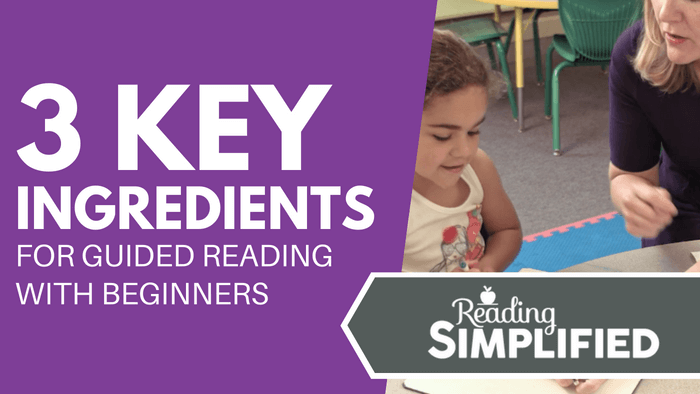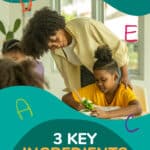
Do you have a non-reader who seems stuck and unable to budge? Or perhaps you have a group of kids who are at a lower reading level, and you’ve got no idea how you can help them climb the reading ladder?
Sound familiar?
Well, I’ve got 3 KEY ingredients for a strong guided reading session for beginners or kids who are considerably behind.
These three features of a guided reading session are designed to accelerate children’s reading ability while easing the stress and pressure you feel as their teacher. Teachers don’t have it easy. We have so much to do and so many questions that are often left unanswered.
Not anymore!
That’s all about to change thanks to these three elements for guided reading with beginners, and I’m really excited to share them with you!
{To watch a video where I am explaining the 3 key ingredients for guided reading with beginners hit play below or read on for a detailed overview.}
1. Teach Blend As You Read Decoding Strategy
My number one tip is to incorporate the "Blend As You Read" decoding strategy in each guided reading session. Many of you may already be using this technique naturally when teaching young readers to read – and that’s great!
However, this reading decoding strategy is in stark contrast to what a lot of us are taught is the “right way” to teach our kids to read. This is what I like to call, the “sound, sound, sound = word” approach. But this dated teaching tactic has a lot of flaws because a child might be able to make three sounds, but when it comes to blending four or five sounds, things come crashing down.
Here are two things to keep in mind when you want to teach non-readers the blend as you read strategy:
1. Teach it in the context of word work activities. At Reading Simplified, we call that word work activity “Read It.”
2. Encourage your kids to blend as they read a new text.
The first step is to practice the Blend As You Read strategy in isolation in Word Work and then put it into play with an actual text for guided reading or when the child is reading aloud to you.
GOLDEN TIP: Remind the student to put sounds together as they read, rather than saying each sound in isolation – blending is key!
When you teach the blend as you read decoding strategy, the student is almost guaranteed to have an “Ahah!” moment. This sudden revelation turns the light bulb on in their heads, and they’re able to understand how the code works. Great! You’ve finally got through to them, and now they’ll get even more excited about reading and will want to tackle more and more words!
2. Buddy Read the Hard Words
Sometimes you need to lend non-readers a helping hand – and that’s okay!
In the beginning, our kids will need a lot of help from the get-go. You might start them with a piece of text and read 95% of the words for them, but as their reading skills improve, that percentage will start to decrease. Before you know it, you’re reading 75% of the words and then 50% - it’s a snowball effect!

It’s crucial to make beginner readers feel good about themselves. Most reading programs focus on letter sounds and a select few words at the beginning, which is fine, but it’s not giving our kids the chance to push themselves and discover their true potential.
With buddy reading and Blend As You Read, a student who only knows a handful of letter sounds can accomplish a lot more in a shorter space of time. They can do something that thrills them, and by having a positive reading experience, they feel like they’ve accomplished something, and this allows them to tune into a higher level of activated brain power because the child is excited.
3. Help Develop a Brief Summarization
In many ways, helping a child to develop a brief summarization is the most important step!
At the end of a text, ask the student to summarize what they just read. Sure, it might not be the most exciting story of all time, but if it has a basic plot, then kids should be able to develop a brief summarization of the storyline.
Young readers will often give you a partial answer. They might say a few words about the story, but they don’t get into detail. When this happens, it’s up to you to draw more out of them, and you can do this by asking a few simple questions:
- What was the story about?
- What happened in the story?
- Who were the main characters?
- What was the problem?
- What was the solution?
Use questions to prompt the student to elaborate on the story. It’s also wise to have the student circle back around and re-state the summary they’ve just created. This challenges them to recall what was read and to restate the summary in their own words.
The summarization stage teaches kids that reading is about more than hard work and decoding. The ability to summarize a piece of text (or anything for that matter) is a fundamental skill that we need as readers.
Developing a summary is the best foundational comprehension strategy skill that kids need to develop their thinking process skills, so make sure to slip it into every guided reading session when you can!
And there you have it, the three best tips to make guided reading more effective and less stressful for you as the teacher. To recap:
Tip 1: Teach the Blend As You Read decoding strategy – help the student put the sounds of the letters together as they go. Teach in isolation and then coach them to do it in the context of reading a new text – easy!
Tip 2: Buddy read the hard words – support the student and read a text that’s mostly decodable, gradually decreasing the proportion of what you read and increasing the percentage that the student reads as their confidence grows.
Tip 3:
Help develop a brief summary – don’t let them walk off after they finish reading the text! Instead, encourage them to deliver a summary and if they give you partial answers, draw out more details with questioning to help them develop this powerful thinking skill.
To learn more about the Blend As You Read decoding strategy, including how to solve the trickiest blending issues, check out this post.
AND, what do YOU think? Please comment below if you've tried all or 1 of these strategies. What do you think of them as package deal for guided reading?





